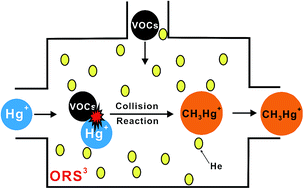ICP-MS/MS as a tool to study abiotic methylation of inorganic mercury reacting with VOCs
Abstract
Methylmercury (CH3Hg) is one of the most widespread toxic contaminants. Although the formation of CH3Hg in aqueous environments has been widely investigated, little information is available on direct anthropogenic or natural emissions of CH3Hg to the atmosphere. In this work, ICP-MS/MS was chosen as a tool to study abiotic methylation of inorganic mercury reacting with VOCs in a gas environment for the first time. We found that the gaseous Hg+ ions were transformed to the more toxic CH3Hg+ ions instantaneously when colliding with some VOCs. Several VOCs, e.g., methyl iodide (CH3I), methylbenzene, acetic acid and ethyl acetate, exhibited good methylation of Hg+ ions with productivities of 1.77%, 1.28%, 1.35% and 1.18%, respectively. Four isotope peaks of CH3199Hg (M = 214), CH3200Hg (M = 215), CH3201Hg (M = 216) and CH3202Hg (M = 217) were identified when Hg+ ions collided with CH3I, and the methyl group in CH3Hg+ was validated by the source of CD3I, indicating that CH3Hg+ ions were formed. This study reveals that the abiotic methylation of Hg+ ions could occur when in contact with the VOCs in the atmosphere, leading to secondary environmental pollution.


 Please wait while we load your content...
Please wait while we load your content...